
The Bottom Line
Pros
- + Fast GPU and SSD all-in-one
- + Impressive 1080p and 1440p performance
- + Super efficient
- + Up to PCIe Gen5 speeds for the SSD
Cons
- - Requires a compatible motherboard for the GPU+SSD combo to work
- - Gaming performance is not a massive leap forward compared to previous-gen
- - 8GB of VRAM could affect the GPU's long-term viability
- - Adding SSD storage increases the price
Should you buy it?
AvoidConsiderShortlistBuyIntroduction
It's not every day that a GPU's functional design makes you double-take. And no, I'm not talking about the physical look where an outlandish-looking shroud, a different fan layout, or over-the-top RGB lighting grabs your attention. I'm talking about a design choice that is both interesting and something we'd like to see more of in the GPU space. For the ASUS Dual GeForce RTX 4060 Ti SSD OC Edition, the answer is in the name - because this a GPU that features an M.2 NVMe SSD slot on the backplate for you to slot in an SSD and then have that pop up as a brand-new storage drive when you fire up Windows.
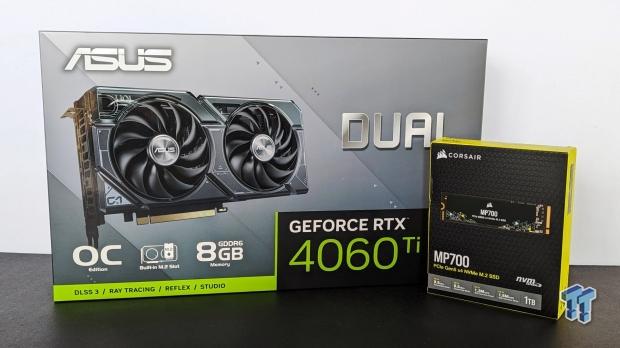
The slot includes full PCI-Express 5.0 x4 support to get the best possible speeds on a modern Gen5-capable motherboard. At this point, you might be wondering why and how. Both are valid questions, so let's get straight to it. NVIDIA's GeForce RTX 4060 Ti is designed with a PCI-Express 4.0 x 8 interface, meaning that when connected to the usual x16 PCI-Express slot on your motherboard, there are 8 unused lanes.
And so ASUS saw this as an opportunity to add an M.2 NVMe SSD slot onto the back of a GeForce RTX 4060 Ti and have the GPU house an additional M.2 slot while running Cyberpunk 2077 with ray-tracing and DLSS 3 Frame Generation. It's a cool concept because you can have all your games installed onto an SSD connected to your GPU! However, getting it to work in the first place is not as simple as it sounds.
PCI-Express 5.0 x4 means that the SSD only uses four lanes, so when the RTX 4060 Ti takes up eight lanes, the leftover eight need to be split and segregated by the motherboard. This means the ASUS Dual GeForce RTX 4060 Ti SSD OC Edition requires a motherboard capable of segmenting the PCIe lanes, otherwise known as "bifurcation." Naturally, there's a list of ASUS boards in this list (plus my MSI board), but it does mean it's a niche product that not every rig can fully use.

Okay, that covers the basics of the SSD side of the ASUS Dual GeForce RTX 4060 Ti SSD; what about the GeForce RTX 4060 Ti side? The good news is that the additional SSD slot has no bearing on the performance of NVIDIA's mainstream GPU - you've still got a powerful 1080p performer with excellent efficiency that excels when you enable NVIDIA's impressive RTX technologies like DLSS Super Resolution, DLSS 3 Frame Generation, and the new Ray Reconstruction.

The Ada Lovelace Generation
Below is a summary of the GeForce RTX 40 Series technology, applicable to all models.
There was a time when outright visual quality was the main driver for determining how advanced real-time rendering, especially in games, had progressed. There was also a time when pure grunt in raw hardware power determined how good a game could technically look and how fast it ran. We're now at a point where visual quality and performance go hand-in-hand, with raw power only being a part of the equation.
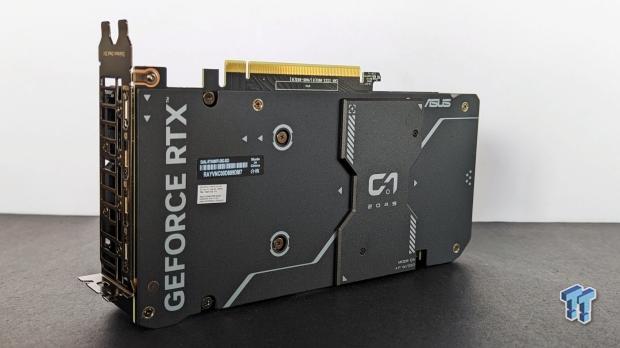
The GeForce RTX 40 Series, the Ada Lovelace generation, is a lineup of GPUs built on a cutting-edge process node while leveraging and evolving all of the advances in AI and hardware-based ray-tracing that NVIDIA helped become mainstream with the GeForce RTX 30 Series.
Named after mathematician Ada Lovelace, considered the world's first computer programmer, the GeForce RTX 40 Series is built on TSMC 4N process technology - a giant leap forward over the Samsung 8nm process used in the GeForce RTX 30 Series Ampere generation. From a pure numbers perspective, the full NVIDIA Ada GPU features 76.3 billion transistors, up to 18,432 CUDA Cores (70% more than the previous gen), and delivers clock speeds over 2.5 GHz while maintaining the same power requirements of the GeForce RTX 3090 Ti.
Ada also introduces the latest generation of RT and Tensor Cores, with the latter introducing brand-new hardware responsible for the next iteration of AI rendering - DLSS 3. NVIDIA's DLSS or Deep Learning Super Sampling is one of the reasons why raw power is no longer the be-all-end-all; it's an AI-based form of upscaling that can provide a sizable boost to in-game performance without sacrificing visual fidelity. In fact, in some cases, it can improve upon native rendering.

For this reason alone, DLSS and other forms of algorithm-based upscaling have become some of the most talked about bits of technology in the PC gaming space. NVIDIA continues to push DLSS, where almost a year after Ada's debut, DLSS 3.5 Ray Reconstruction brought the power of AI to improve the image quality of ray-tracing effects dramatically.
Free frames, enough said.
As for DLSS 3, it combines DLSS Super Resolution (DLSS 2) with NVIDIA Reflex to reduce system latency and the brand-new hardware-accelerated Frame Generation technology. Three bits of rendering tech = DLSS 3. And it's exclusive to the GeForce RTX 40 Series.
And it's here where NVIDIA has done real-time graphics upscaling to the idea of frame interpolation - or what they call Motion Plus in the TV world. Which, to be fair, is not a fair comparison on account of tech like Motion Plus being - well - terrible. But the fundamental idea is the same, albeit using specialized AI hardware in the GeForce RTX 40 Series graphics cards to generate and create entire frames.
The results are impressive - with dramatic improvements to overall performance (in the smoothness stakes) in games like Cyberpunk 2077, Diablo 4, Alan Wake 2, and many more. In just over a year, DLSS 3 Frame Generation has become mainstream and is being widely adopted by developers and publishers.
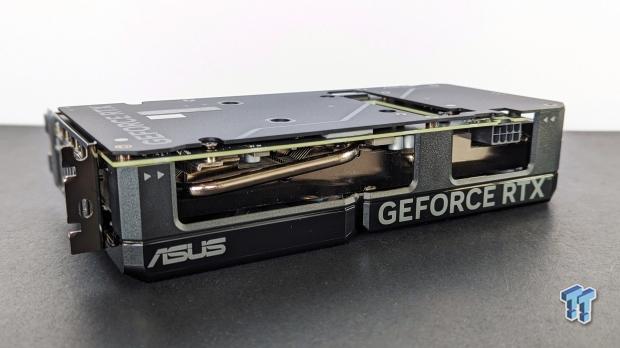
The Ada generation is much more than "smaller = more," with NVIDIA introducing back-end technology in the form of Shader Execution Reordering - which effectively ensures render tasks happen more efficiently and without running into bottlenecks. This means a leap forward in the real-time rendering of hardware-intensive ray-tracing effects.
The Ada generation also levels up NVIDIA's already formidable content creation chops with the arrival of AV1 encoding for better video quality for streamers without sacrificing performance or bandwidth.
Specs and Test System
Specifications
Here, we can see how the specs and hardware stack up for the GeForce RTX 4060 Ti compared to the previous generation's GeForce RTX 3060 Ti and this generation's GeForce RTX 4070.
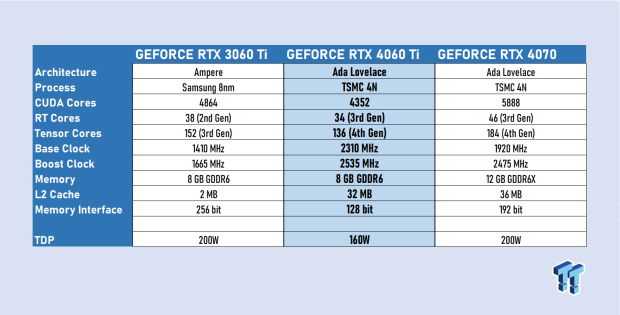
Comparing the GeForce RTX 4060 Ti numbers to the GeForce RTX 3060 Ti (one of the most popular GPUs from the Ampere generation), you're looking at a card that can do more with less: fewer CUDA Cores, RT Cores, and even AI Tensor cores. Throw in a cut-down memory interface to 128-bit from 256-bit, and you might expect that the GeForce RTX 4060 Ti's in-game performance would be a step down - it isn't.
There are answers for why, for most of the specs decisions: for the RT and Tensor Cores, you're looking at next-gen versions. Hence, they're more powerful and not a like-for-like comparison, and with the addition of 32MB of L2 Cache, the effective memory bandwidth increases dramatically.
On top of this, you've got a massive, almost 1GHz increase in Boost Clock speed - which the ASUS Dual GeForce RTX 4060 Ti SSD pushed to 2595 MHz in OC Mode. Usually, boosting clock speeds means increasing the overall power draw and sacrificing efficiency - but with the incredibly efficient Ada Lovelace architecture, the ASUS Dual GeForce RTX 4060 Ti SSD manages to improve 1080p gaming performance over the GeForce RTX 3060 Ti while consuming 26.5% less energy. It does so while remaining quiet and cool and also housing an SSD.
This is all stuff we learned when we reviewed the first GeForce RTX 4060 Ti cards in 2023, so let's shift gears to the built-in M.2 SSD slot. With tool-free installation, installing an SSD on the backplate is simple - with ASUS supplying thermal pads to apply and easy-to-follow instructions. For this review, ASUS sent a Corsair MP700 1TB PCIe 5.0 x4 NVMe M.2 SSD for testing - and you can see the full results toward the end of this review.
Adding an M.2 slot on the back of the GeForce RTX 4060 Ti increases the GPU's overall price, with the MSRP of $399 USD rising by 10% to around $440. This brings us to one of the more vocal criticisms levied at the GeForce RTX 4060 Ti when it launched - maintaining the 8GB of VRAM capacity found in both the GeForce RTX 3060 Ti and GeForce RTX 4070. Extra VRAM doesn't mean you get increased performance, at least not by default - but with some modern AAA titles requiring over 8GB of VRAM to max out settings fully, 8GB does mean you'll need to tweak settings to achieve optimal performance with the GeForce RTX 4060 Ti.
- GPU: NVIDIA GeForce RTX 4060 Ti
- Model: ASUS Dual GeForce RTX 4060 Ti SSD OC Edition
- Interface: PCI Express 4.0
- CUDA Cores: 4352
- Tensor Cores: 136 (4th Generation)
- RT Cores: 34 (3rd Generation)
- Clocks: OC Mode: 2595 MHz, Default More: 2565 MHz
- Memory: 8GB GDDR6
- Memory Speed: 18 Gbps
- Memory Interface: 128-bit
- Total Memory Bandwidth: 288 GB/s (554 GB/s effective)
- L2 Cache: 32768 K
- Display Connections: 3 x DisplayPort, 1 x HDMI 2.1 x 1
- Power Connectors: 1 x PCIe 8-pin cable
- Recommended PSU: 550W
- What's in the Box: ASUS Dual GeForce RTX 4060 Ti SSD OC Edition, 1 x Collection Card, 1 x Speedsetup Manual, 1 x Install Manual, 1 x Thank you card, 1 x SSD Metal Cover, 1 x Parts Package
Kosta's Test System
- Motherboard: MSI MPG X670E Carbon Wi-Fi
- CPU: AMD Ryzen 9 7900X
- Cooler: Corsair iCUE H100i RGB PRO XT Liquid CPU Cooler
- RAM: 64GB (2x32GB) Corsair DOMINATOR PLATINUM RGB DDR5 DRAM 5200MHz
- SSD: Sabrent Rocket 4 Plus-G M.2 PCIe Gen 4 SSD 4TB, Sabrent Rocket 4 Plus M.2 PCIe Gen 4 SSD 8TB
- Power Supply: Thermaltake Toughpower GF1 850W
- Case: Thermaltake Core P3 Tempered Glass Snow
- OS: Microsoft Windows 11 Pro 64-bit
Physical Design and Cooling
Choosing the Dual design for its little SSD experiment was the right choice as the more compact form factor paired with excellent cooling make the addition of the M.2 slot on the back feel like a natural extension of the design. With dimensions of 220.72 x 120.324 x 40.96 mm, it's the sort of GPU that most won't have an issue with installing in a case - with the bonus of not having to worry about GPU sagging or installing braces for additional support.

The Dual aesthetic is one of my favorites, too, which comes down to a fully enclosed look with a protective metal backplate, transparent sections, a stainless steel bracket, and an open top so you can see the heatsink. On the front, you've got two large, high-quality Axial-tech fans with 0dB technology that has them turned off when you're not gaming but also when you're engaging in some light, not all that demanding gaming.
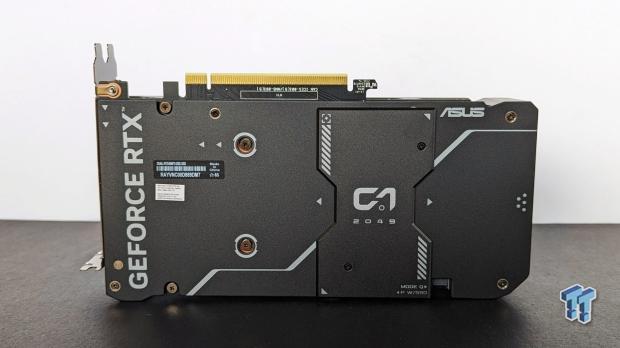
The thermal design and thermal performance of the ASUS Dual GeForce RTX 4060 Ti SSD OC Edition are excellent - and this extends to the SSD side of the card, too. The metal backplate is made from lightweight aluminum, an excellent choice for dissipating the heat generated by an M.2 SSD. Also, thermal pads transfer heat from the SSD directly onto the GPU's heatsink. So, even though it might sound like placing an SSD on a PC component that is known for generating heat is not the smartest of ideas - it's pretty clever because you can leverage the over-the-top cooling found on a GPU to cool a super-fast PCIe Gen5 SSD while maintaining optimal performance.
Benchmarks - 15 Game Averages
The Games and Tests
PC gaming is a complicated and varied space, from indie games to major blockbuster releases and titles that push hardware and technology to their limit with the adoption of effects like real-time ray-tracing.
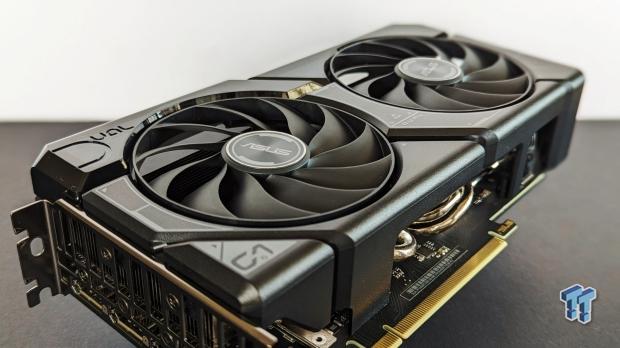
This is all a way of saying that the 15 in-game benchmarks we've chosen (and run at 1080p and 1440p) represent a wide range of styles, not only in terms of genres, like first-person shooters and racing games but also in the API technology (DirectX 11, 12) and cutting-edge features like ray tracing and upscaling technology.
Results include DLSS and FSR 2, where possible, as both technologies are the sorts of things, especially in 1440p and 4K, which you'd turn on. Six of the 15 game benchmarks also feature ray tracing, a great way to see the additional benefit of NVIDIA's DLSS and Frame Generation technology. Also, each title is set to ultra-equivalent quality settings to push GPU hardware and minimize CPU bottlenecks at higher resolutions.
Also, it's just fun to max out a game's visual settings and see the results. Here's the breakdown of games, graphics settings, and what's being tested.
- Assassin's Creed Valhalla: Ultra High-quality settings, with the in-game benchmark tool used.
- Borderlands 3: Ultra quality settings, with the in-game benchmark tool used.
- Call of Duty: Modern Warfare II: Ultra quality setting, in-game multiplayer benchmark tool used.
- Cyberpunk 2077: Ultra quality setting, in-game benchmark tool used. AMD FSR and NVIDIA DLSS results are included.
- Cyberpunk 2077 (RT): Ray tracing Ultra quality setting, in-game benchmark tool used. AMD FSR and NVIDIA DLSS results are included.
- DOOM Eternal (RT): Ultra Nightmare quality setting with ray-tracing enabled, the opening of Mars Core campaign level used to benchmark.
- F1 22 (RT): Ultra High-quality setting with ray tracing, one lap of the Bahrain track benchmarked. AMD FSR and NVIDIA DLSS results are included.
- Forza Horizon 5 (RT): Extreme quality setting with ray tracing enabled, in-game benchmark tool used. AMD FSR and NVIDIA DLSS results are included.
- Hitman (RT): Ultra-quality settings with ray-tracing, Dubai scene benchmarked. AMD FSR and NVIDIA DLSS results are included. A May 2023 update to the game has greatly improved performance, so comparison results for this game are excluded for now (but still factored into the averages).
- Horizon Zero Dawn: Ultimate quality setting, in-game benchmark used.
- Marvel's Guardians of the Galaxy (RT): Ultra quality setting with ray tracing enabled, the in-game benchmark tool used.
- Rainbow Six Extraction: Ultra quality settings and in-game benchmark tool used.
- Red Dead Redemption 2: Maximum quality settings, with in-game benchmark tool used. AMD FSR and NVIDIA DLSS results are included.
- The Division 2: Ultra quality settings with in-game benchmark tool used.
- Total War: Warhammer III: Ultra-quality settings with the in-game Battle Benchmark tool used.
15 Game Average FPS - 1080p Results
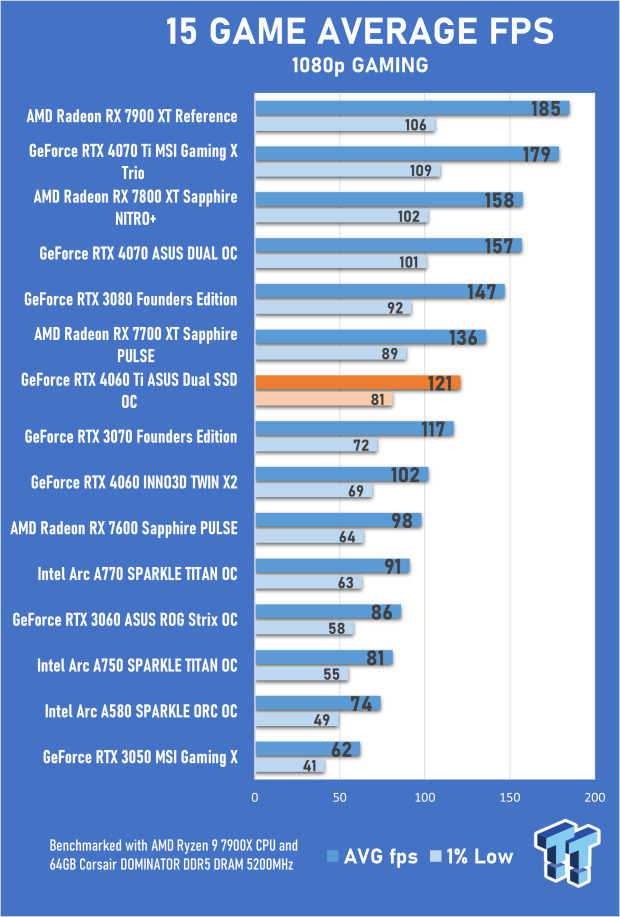
In all marketing, NVIDIA positions the GeForce RTX 4060 Ti as a high-end 1080p card, and it's not hard to see why - the performance at this resolution is impressive - 18.6% faster than the GeForce RTX 4060 and 3.4% faster than the GeForce RTX 3070. A card that is weirdly still being sold for more than the GeForce RTX 4060 Ti. What makes these results even more impressive is that the RTX 4060 Ti and NVIDIA's Ada Lovelace are incredibly efficient - the card outclasses the GeForce RTX 3070 when it comes to 1080p gaming and does so using 33.5% less energy.
However, there is a bit of a performance gap between the ASUS Dual GeForce RTX 4060 Ti SSD OC Edition and the next model up in the RTX 40 Series line-up - the GeForce RTX 4070 ($549 USD). A gap of 22.9% isn't as bad as it seems when you factor in the larger price percentage difference between these GPUs. Compared to its closest Radeon competitor, the more premium and power-hungry Radeon RX 7700 XT, the RTX 4060 Ti is 11% slower across our 15-game benchmark suite. This margin, though, changes depending on the title, with the GeForce GPU generally performing a lot closer when it comes to titles with real-time ray-tracing.
15 Game Average FPS - 1440p Results
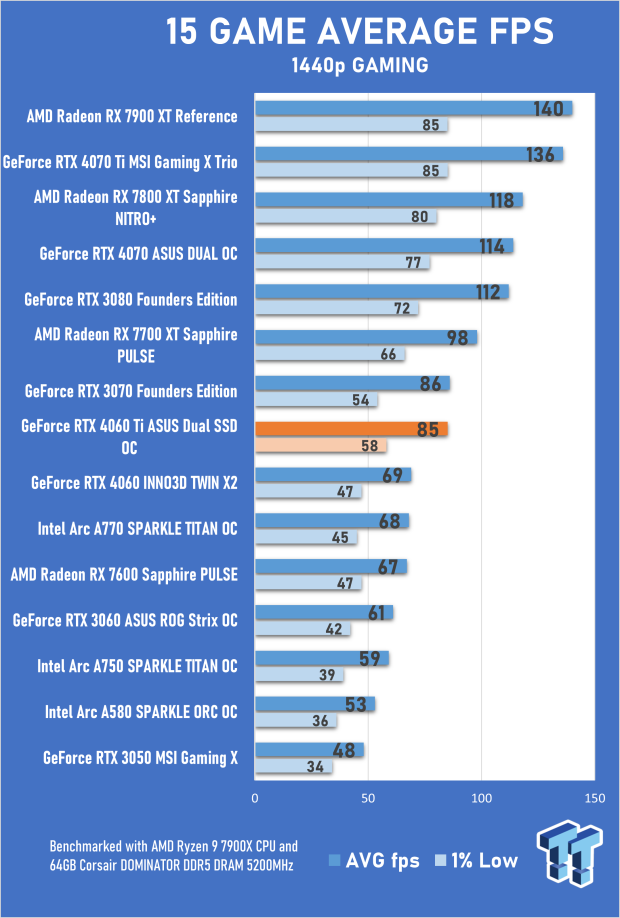
With a 121fps average 1080p gaming frame rate across our 15-game benchmark suite, the notable 29.8% performance drop-off when increasing the resolution to 1440p doesn't mean that the ASUS Dual GeForce RTX 4060 Ti SSD OC Edition isn't a solid 1440p performer. As long as the 8GB of VRAM isn't being taxed too heavily, the 1% low 58fps and overall 85fps performance makes it a great GPU to pair with a 1440p display - the fastest growing resolution in PC gaming, according to the latest Steam hardware survey.
The ASUS Dual GeForce RTX 4060 Ti SSD is 23.2% faster than the GeForce RTX 4060 at this resolution, performing on par with the GeForce RTX 3070 - a card still brilliant for day-to-day PC gaming. Of course, with the RTX 4060 Ti, you've got DLSS 3 Frame Generation (more on this below) and the improved efficiency and content creation features of the Ada generation. So you've got the same level of performance as the RTX 3070, with the ASUS Dual GeForce RTX 4060 Ti SSD consuming 32.5% power.
At 1440p, the GeForce RTX 4060 Ti's average performance across our 15-game benchmark suite is 13.3% slower than the Radeon RX 7700 XT - a 245W card compared to the 160W of the GeForce RTX 4060 Ti. Even though the ASUS Dual GeForce RTX 4060 Ti SSD is limited to 8GB of VRAM, the additional 32MB of L2 Cache does affect the 1% low performance - so even though averages are on par with the GeForce RTX 3070, performance is overall smoother and more consistent-a definite plus.
Benchmarks - 3DMark FireStrike
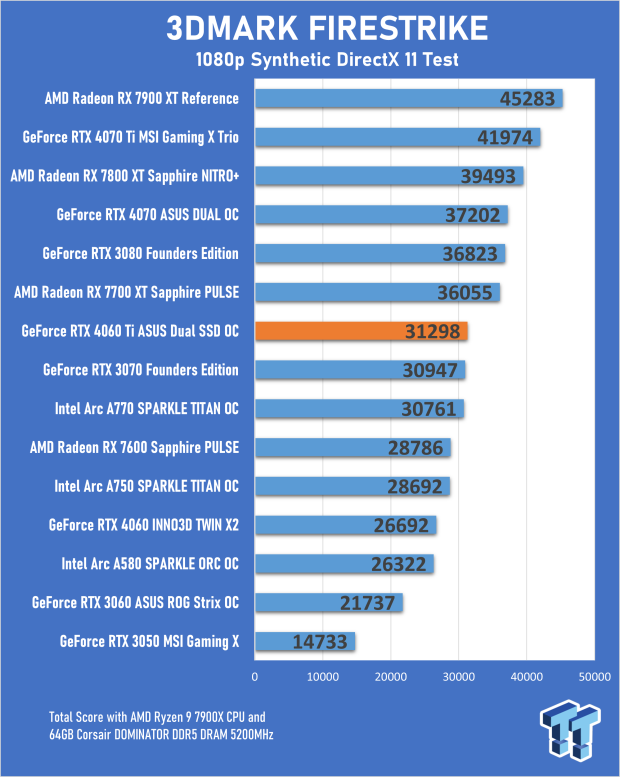
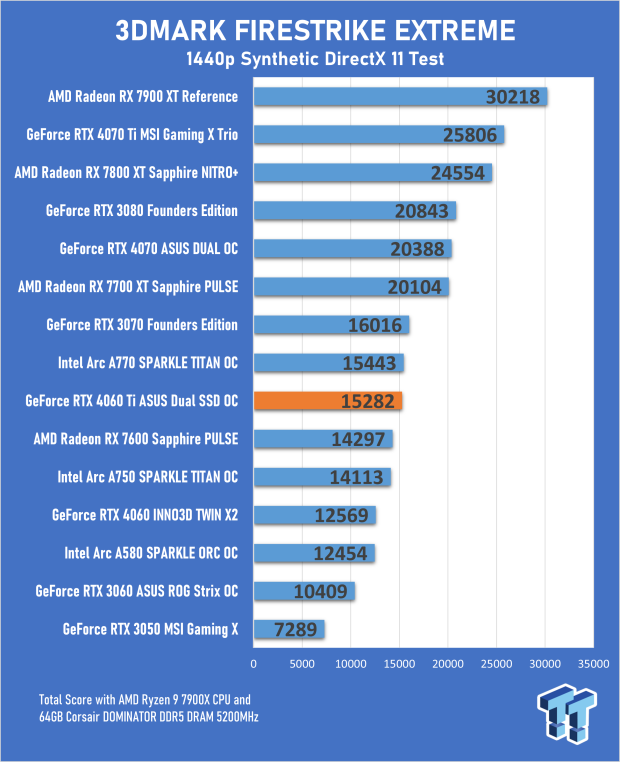
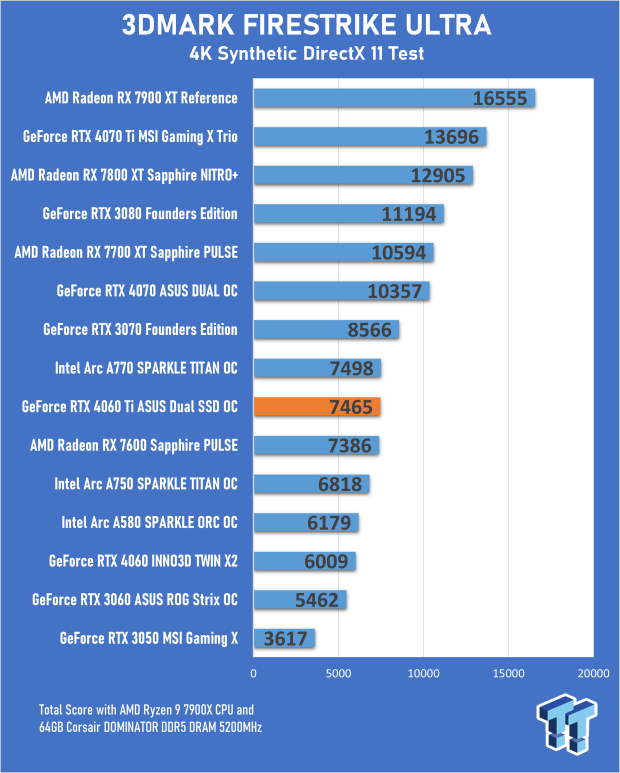
3DMark FireStrike is a synthetic DirectX 11 benchmark, and the results (at least in terms of the GeForce RTX line-up) are somewhat similar to the actual in-game performance we experienced across the three tests covering the resolutions 1080p, 1440p, and 4K. At 1080p, the score is 17.3% higher than the GeForce RTX 4060 while creeping ahead of the GeForce RTX 3070. However, increasing the resolution does mean we get an incorrect representation for the Radeon RX 7600 and Intel Arc series - so the Firestrike results aren't a great indicator of what to expect.
Benchmarks - 3DMark TimeSpy and Port Royal
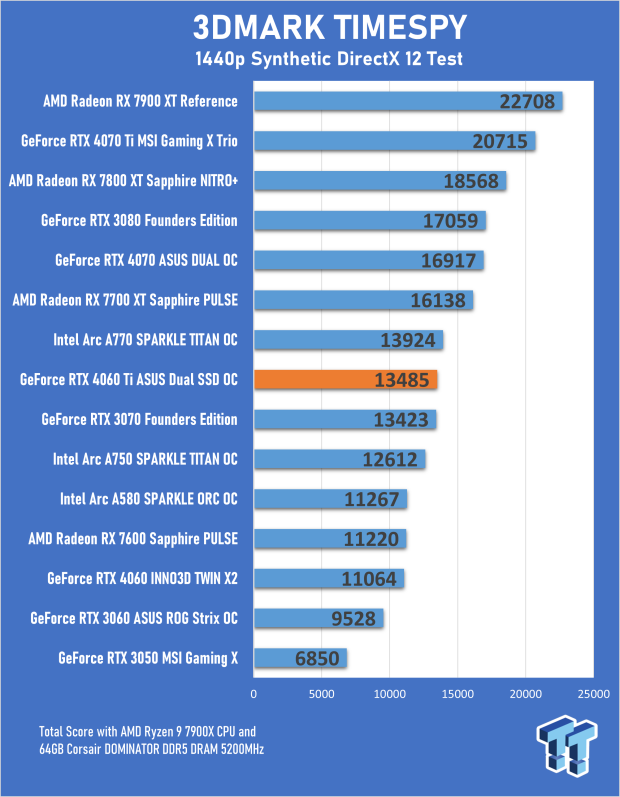
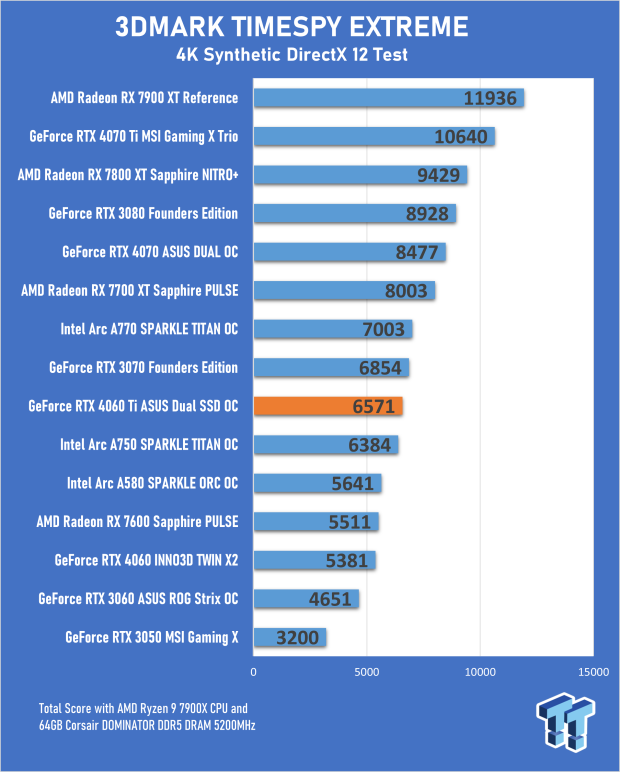
3DMark TimeSpy is a DirectX 12 synthetic benchmark covering 1440p and 4K gaming and is a relevant test for modern PC gaming. Outside of the Intel Arc results, the TimeSpy score for the ASUS Dual GeForce RTX 4060 Ti SSD OC Edition represents a similar story of what to expect from gaming with the card. Performance between the GeForce RTX 4060 and GeForce RTX 4070 is roughly on par with the previous generation's GeForce RTX 3070. The results also showcase that the ASUS Dual GeForce RTX 4060 Ti SSD is not a card you'd use for 4K gaming, as the memory configuration and specs are tuned for 1080p and 1440.
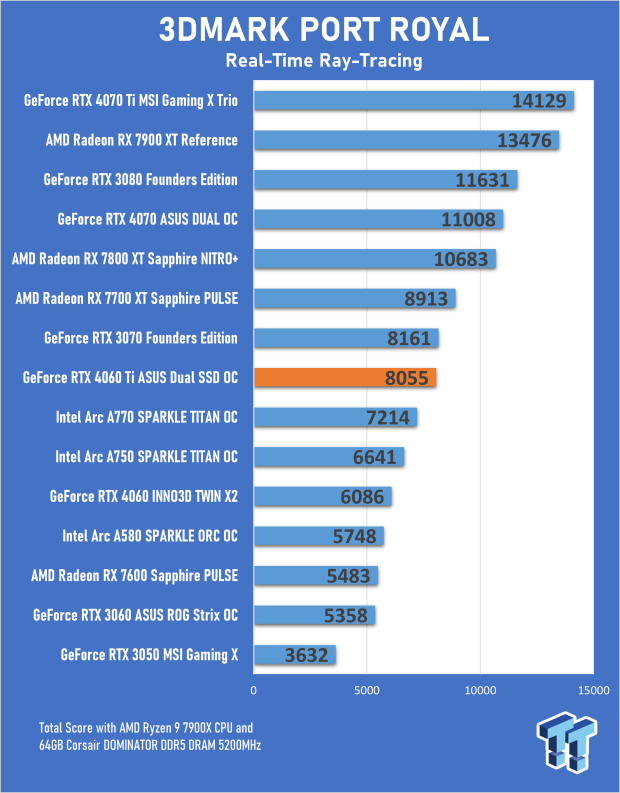
3DMark Port Royal is a synthetic ray-tracing benchmark, an area where NVIDIA's GeForce RTX hardware and Ada architecture excel. However, the overall score is 32% higher than the GeForce RTX 4060 and 26.8% lower than the GeForce RTX 4070 result. In-game results paint a better picture of the GeForce RTX 4060 Ti's ray-tracing performance, where we see a 1% low performance and stability improvement compared to the previous generation - as seen in Cyberpunk 2077 using the Ray-Tracing Ultra quality setting.
Ray-tracing is also the realm of DLSS 2 Super Resolution, DLSS 3 Frame Generation, and the new DLSS 3.5 Ray Reconstruction technology. Combine all three, and the GeForce RTX 4060 Ti becomes an excellent 1080p and 1440p ray-tracing card - where NVIDIA's AI-powered add-on technology improves performance and dramatically improves image quality. This is 100% the case for ray-tracing and games that support DLSS 3.5, with the result being the sort of night-and-day difference that puts NVIDIA's RT performance and quality several steps ahead of the competition.
Benchmarks - 1080p Gaming
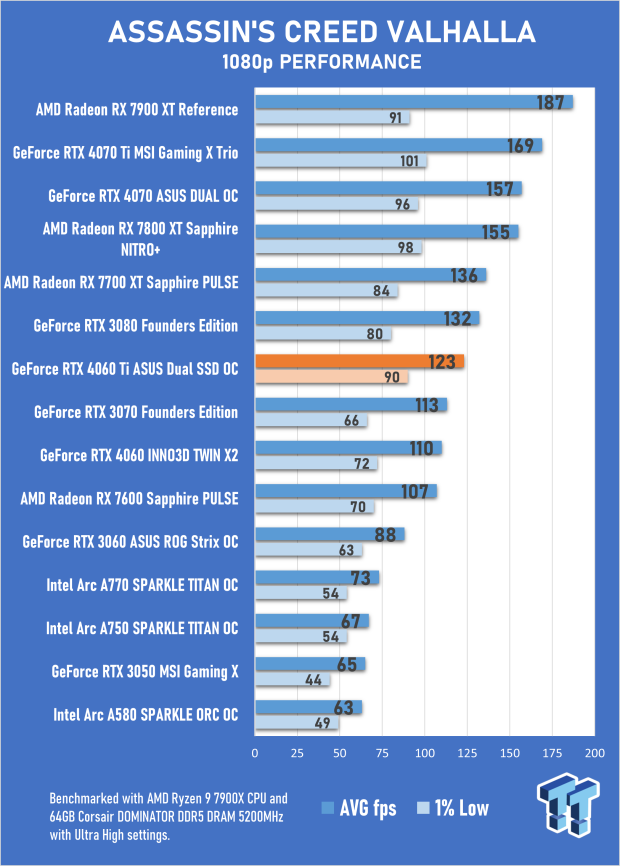
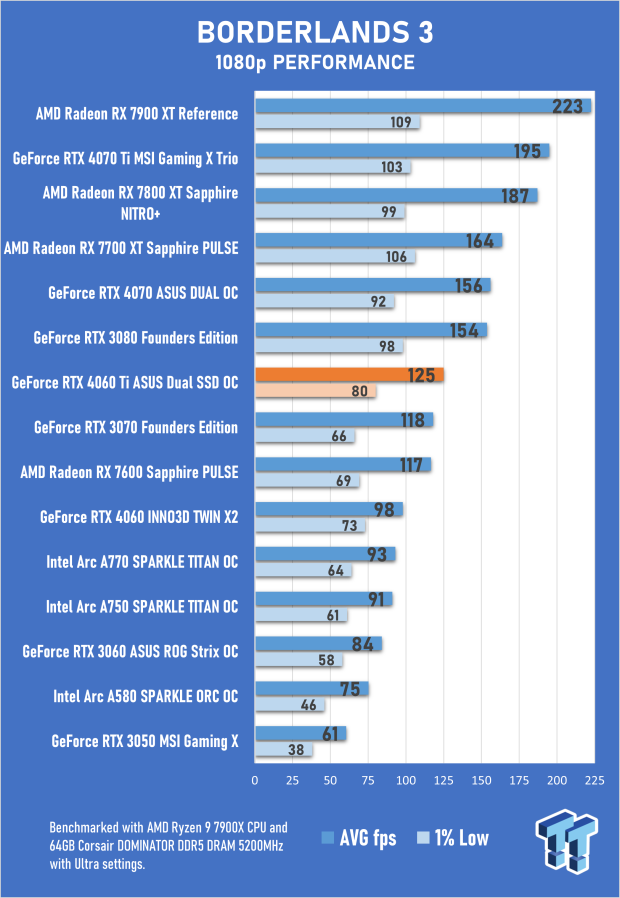
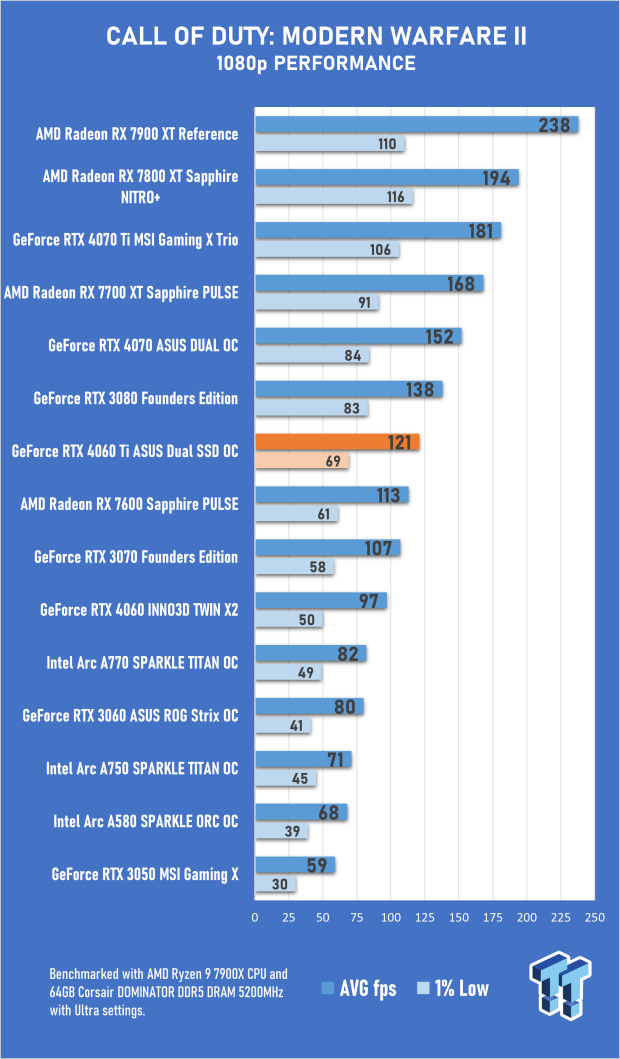
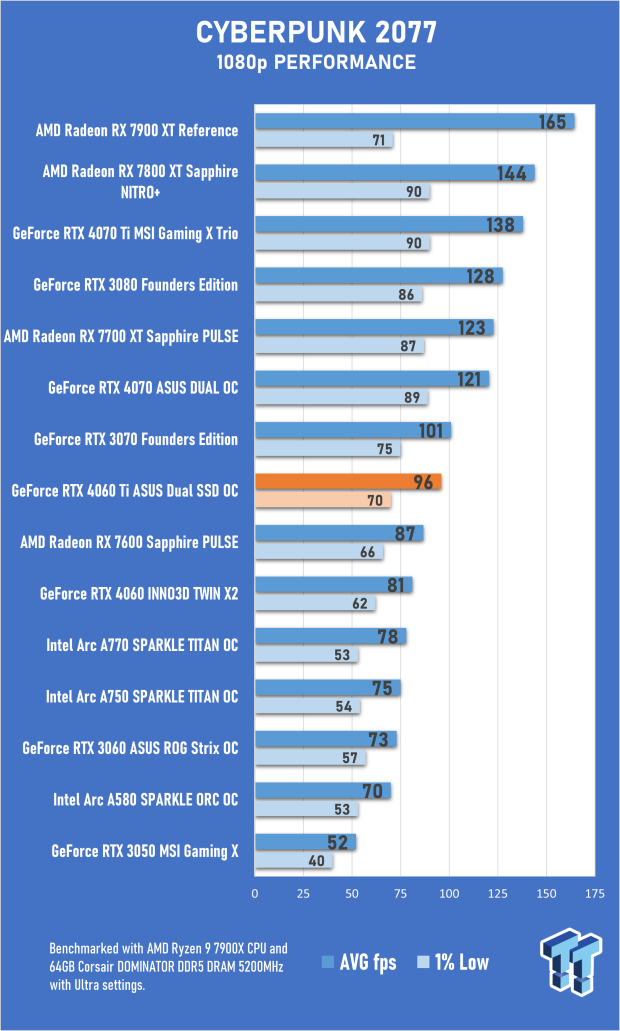
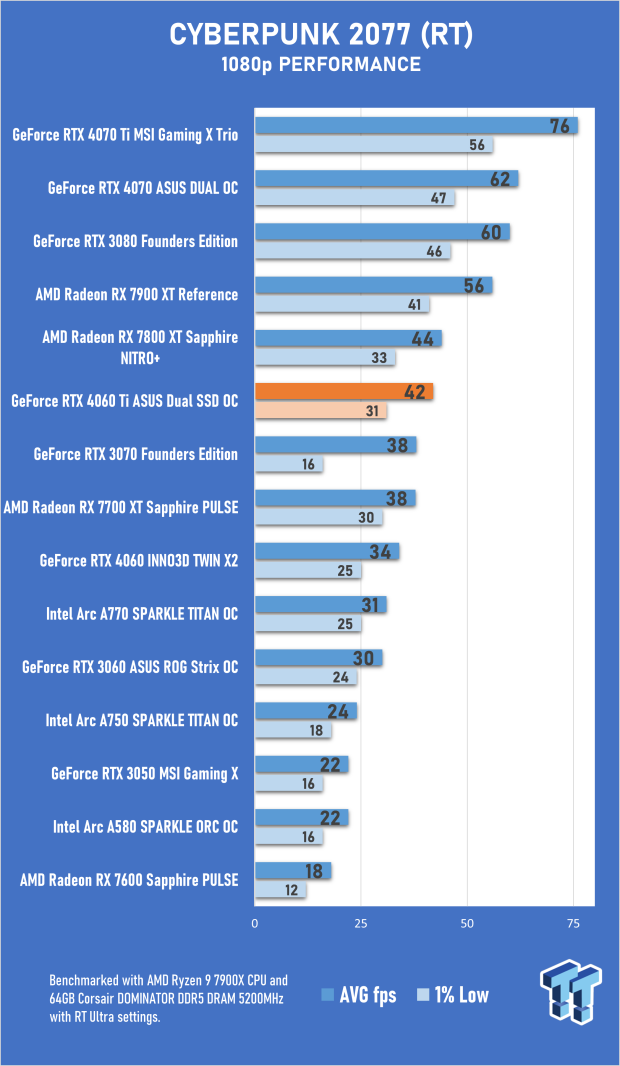
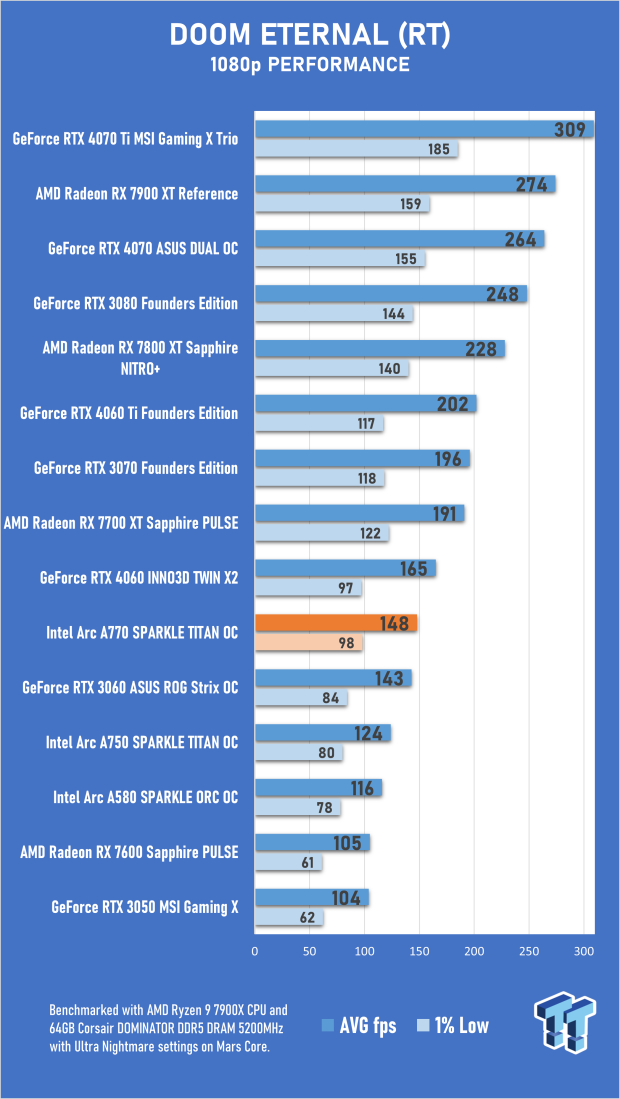
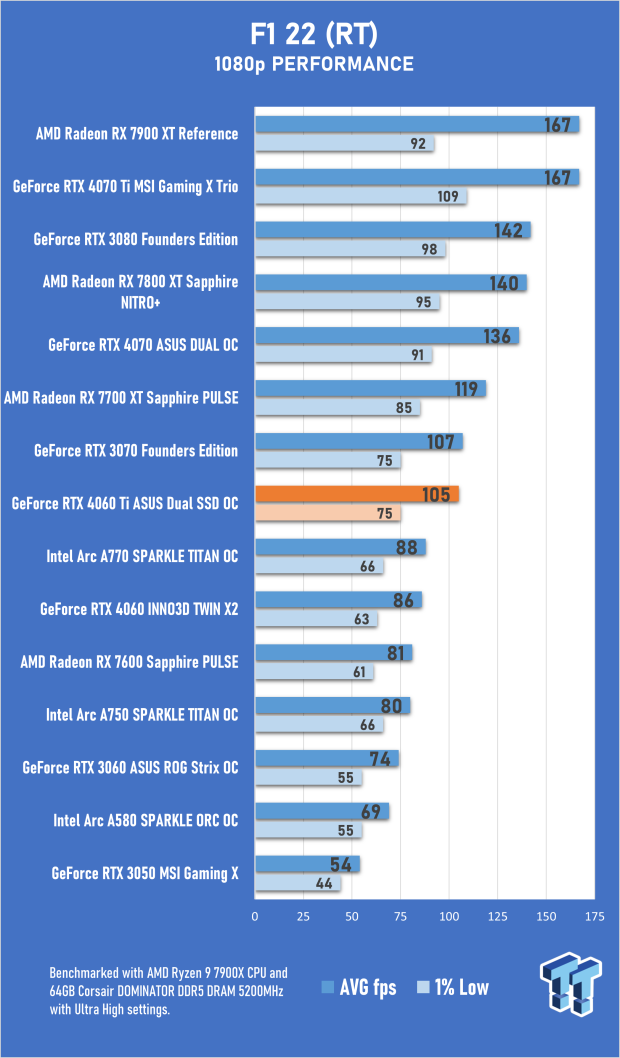
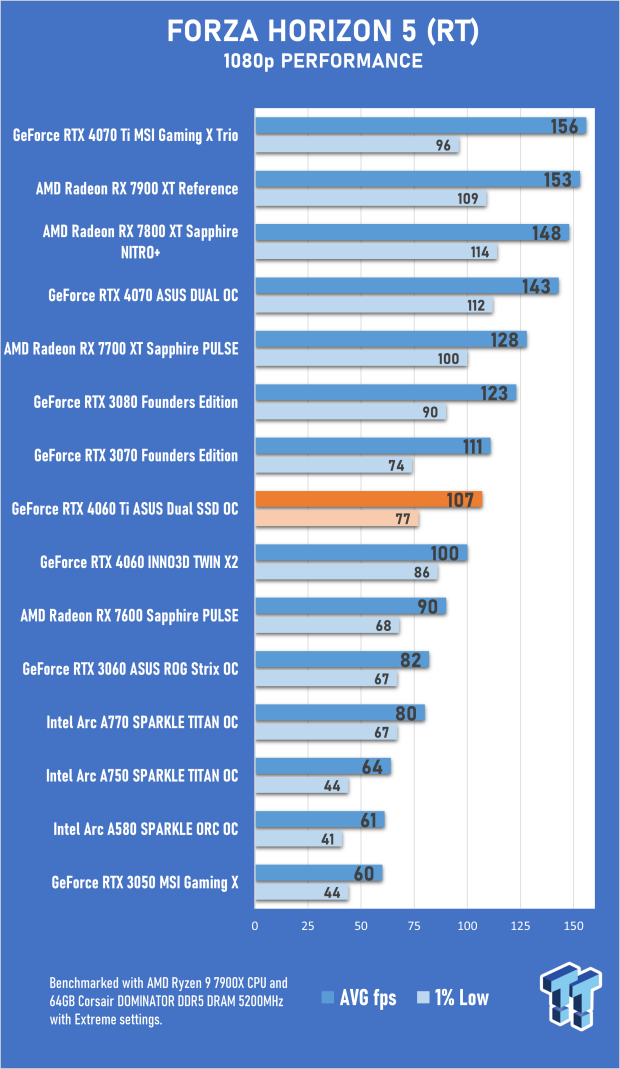
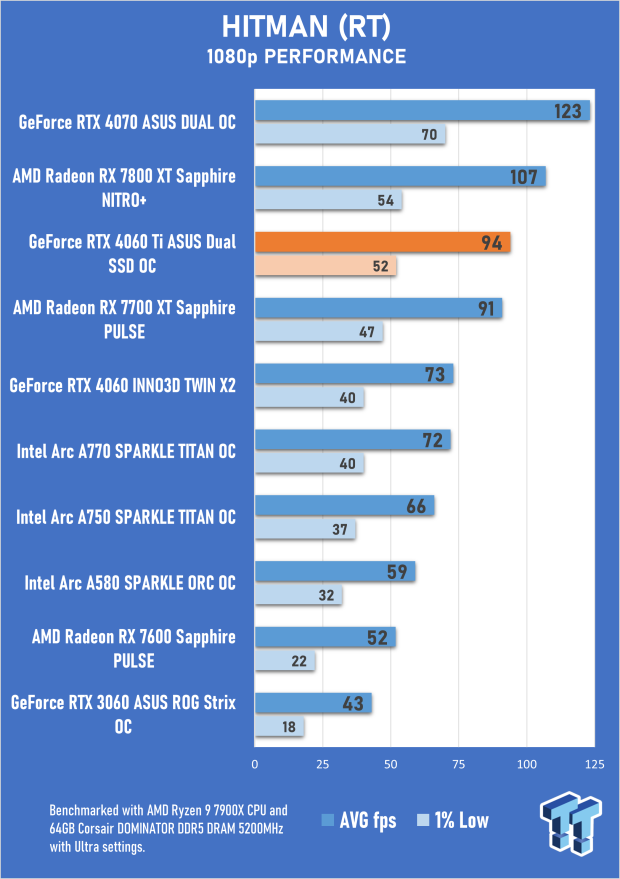
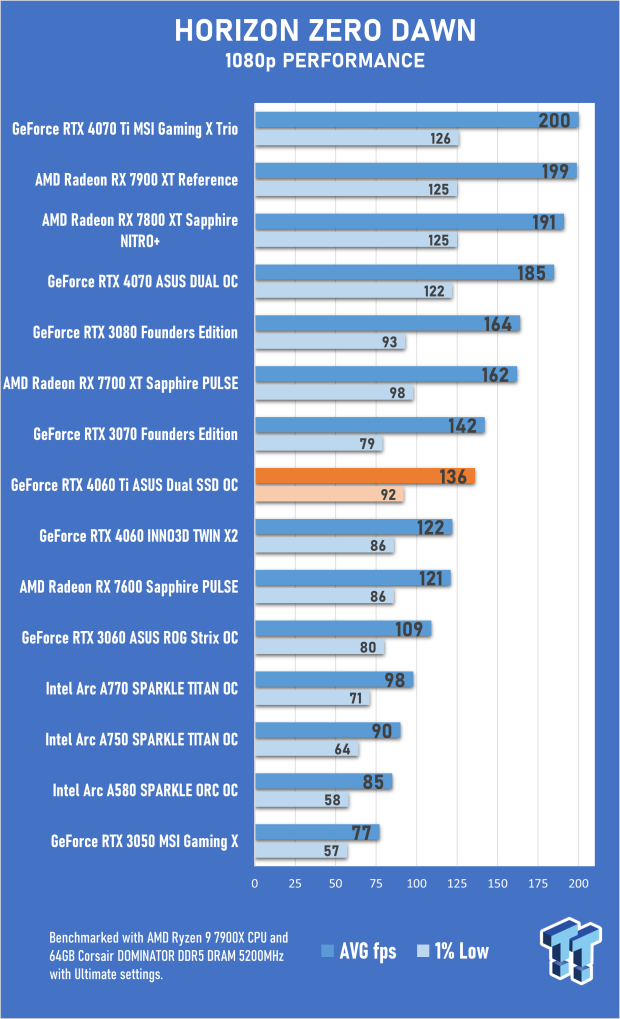
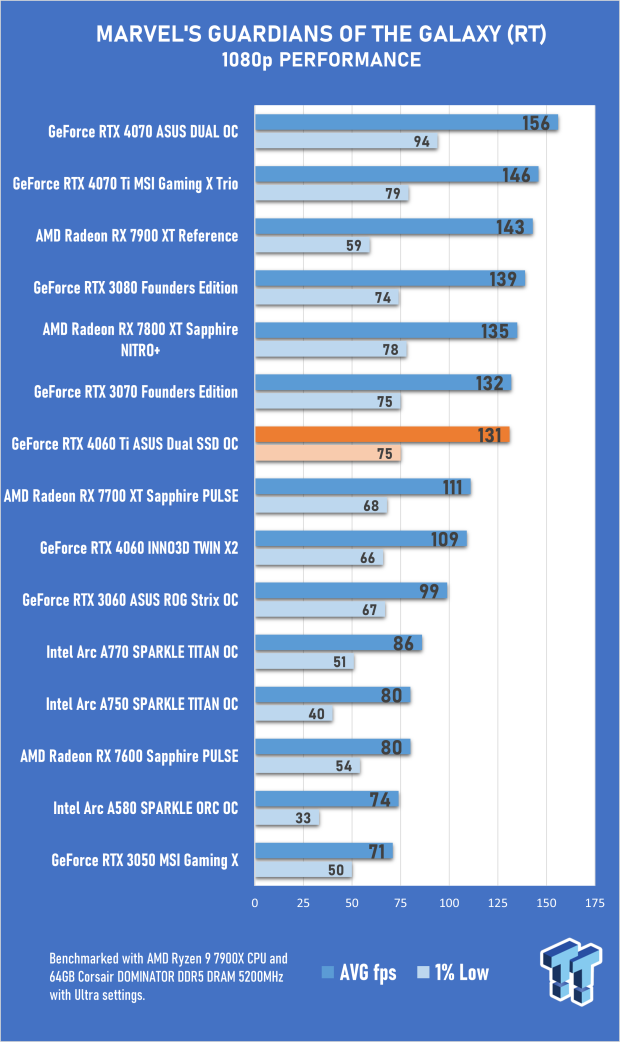
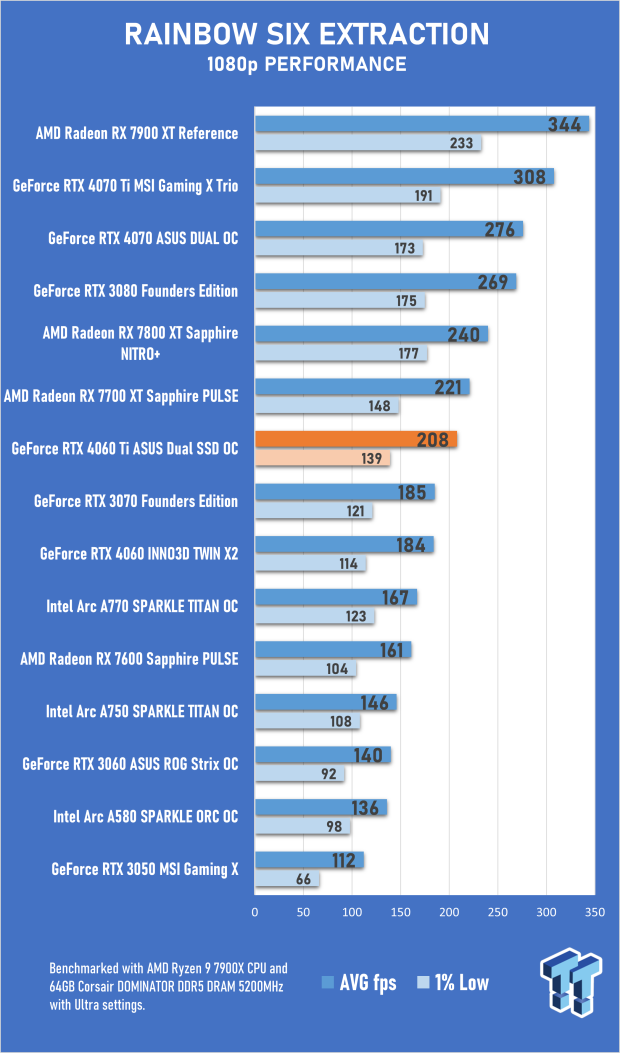
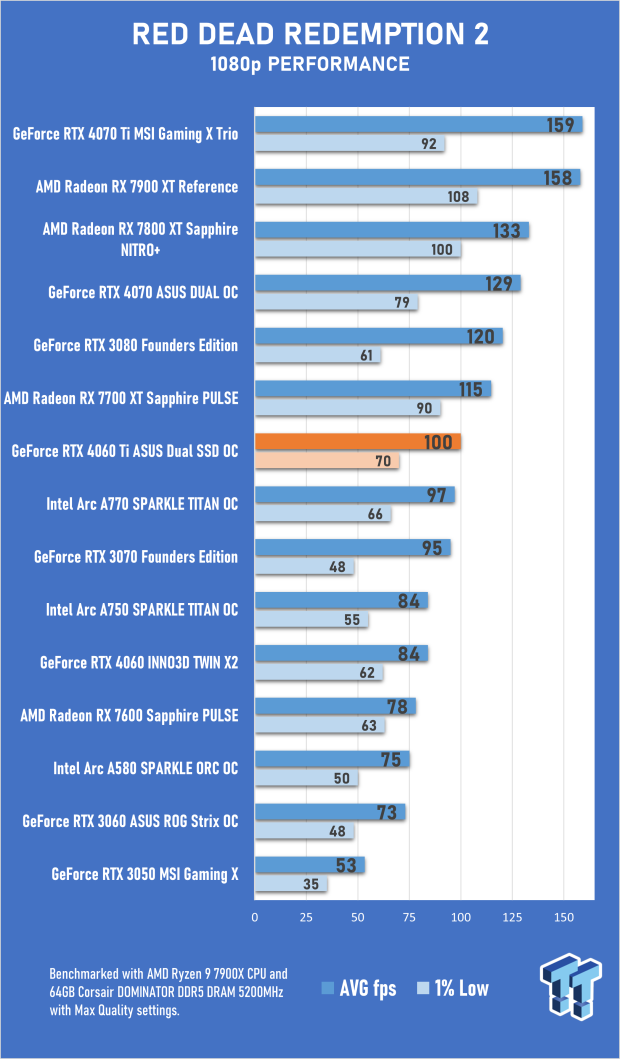
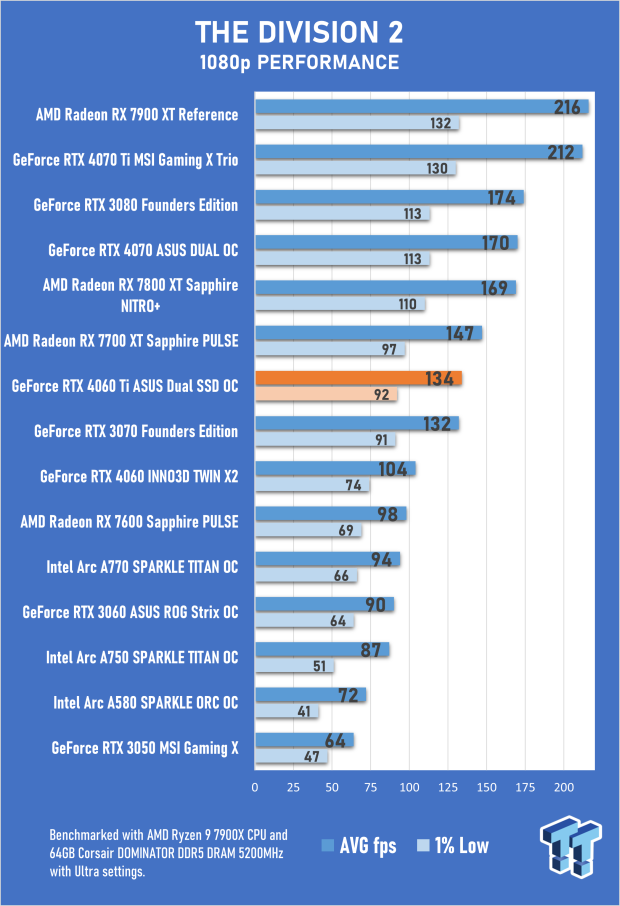
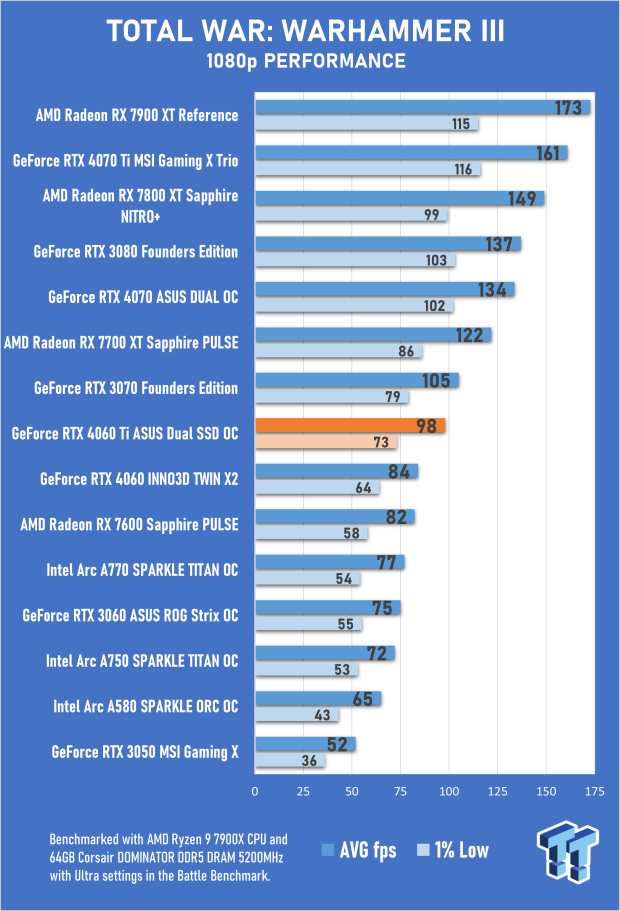
Benchmarks - 1440p Gaming
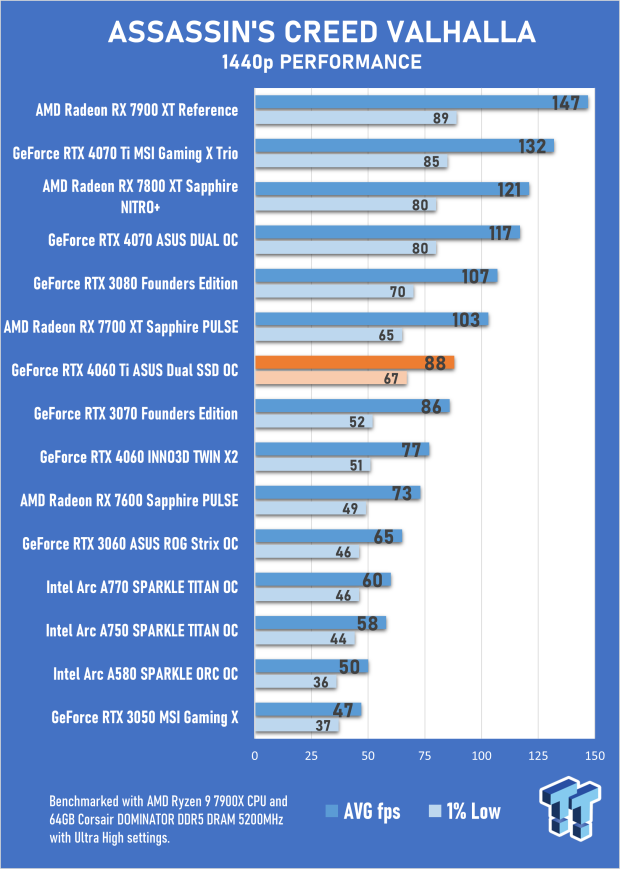
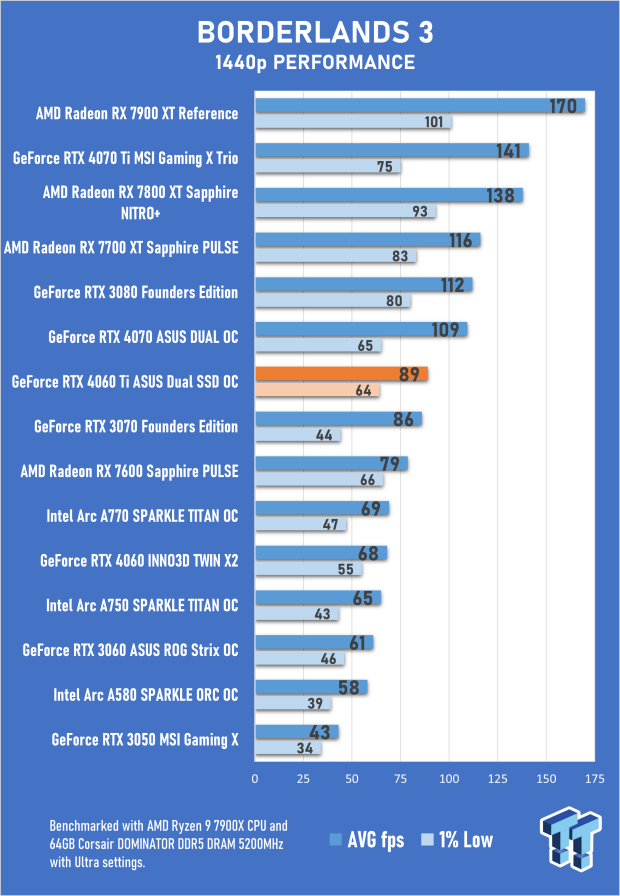
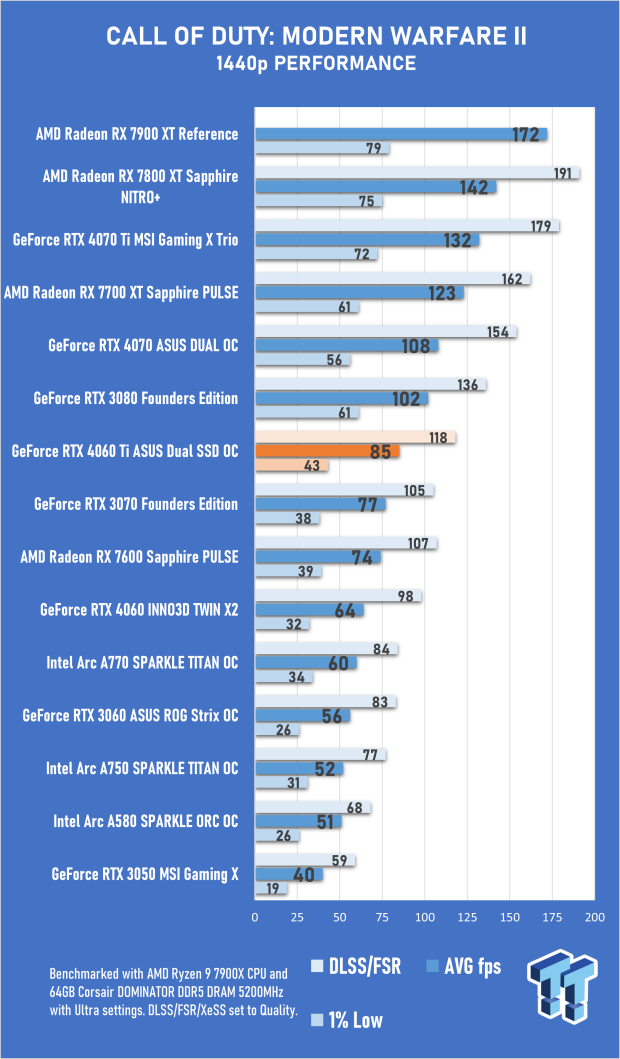
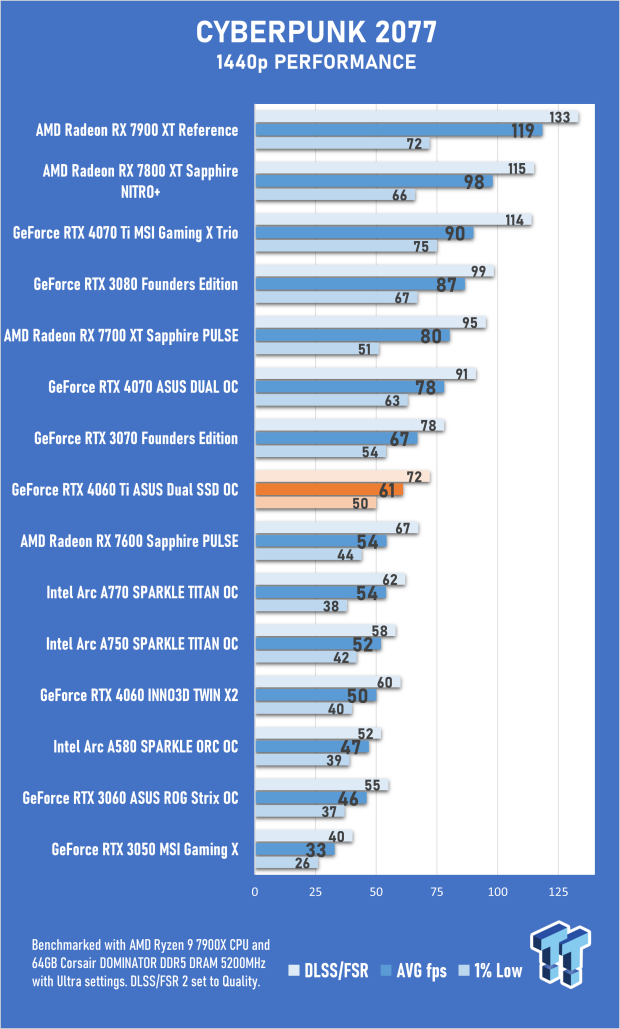
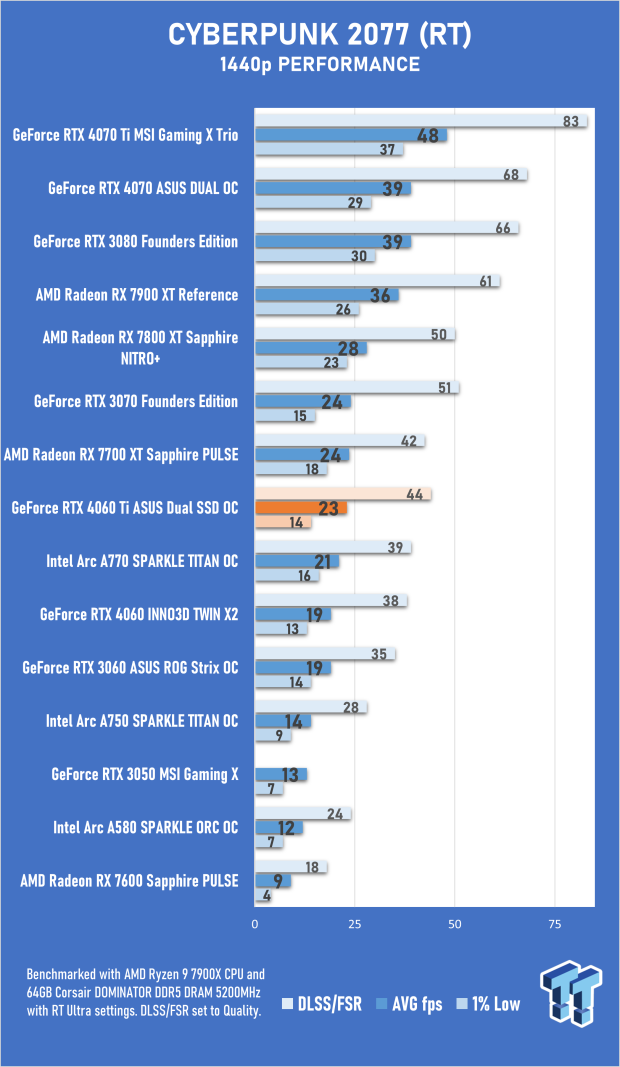
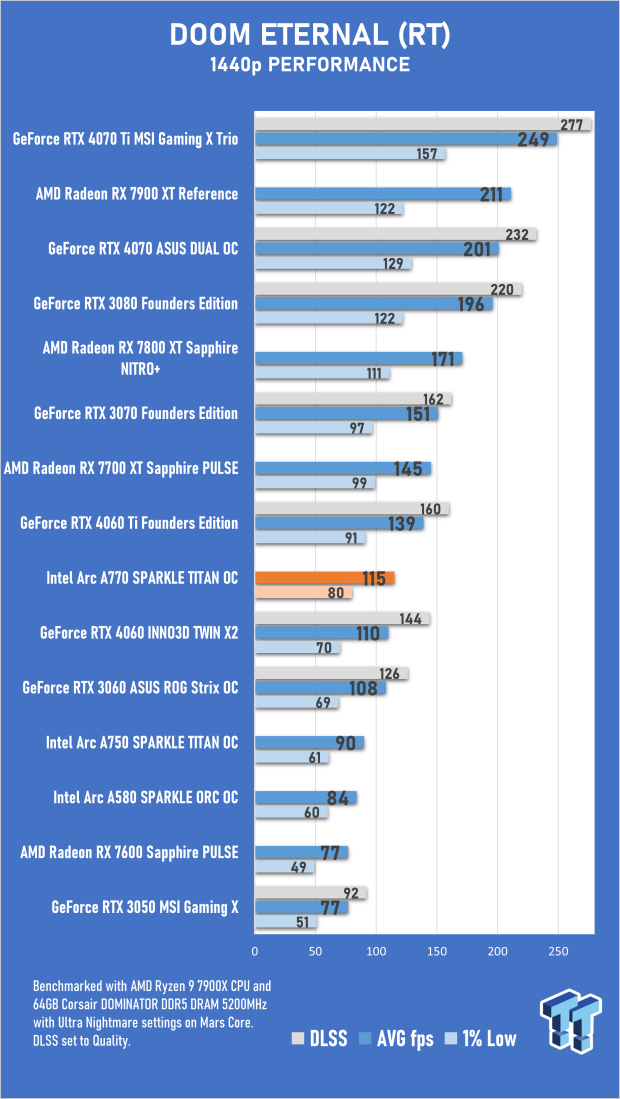
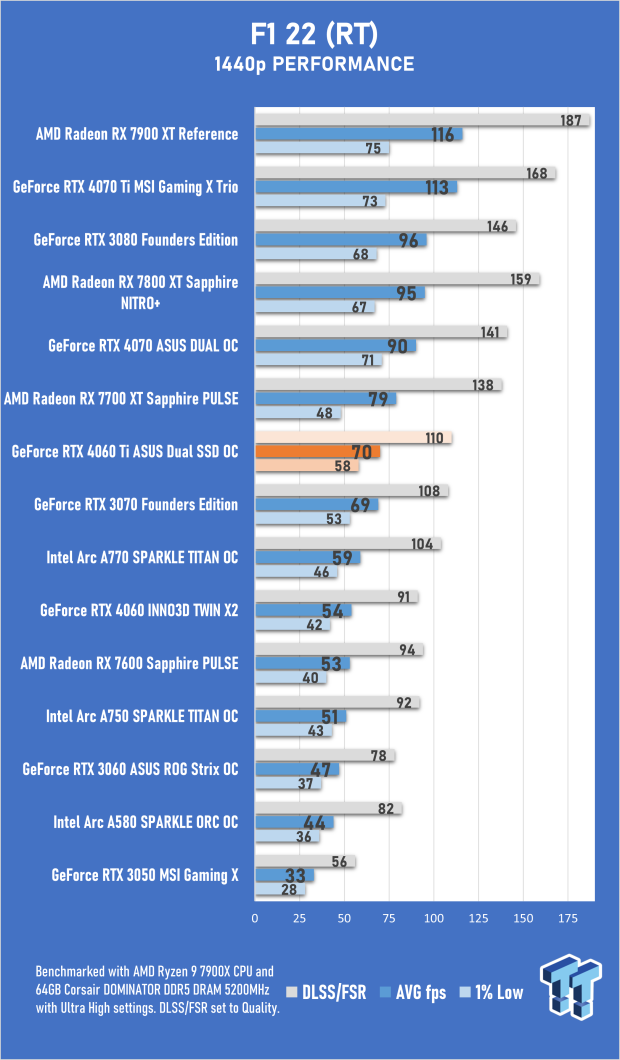
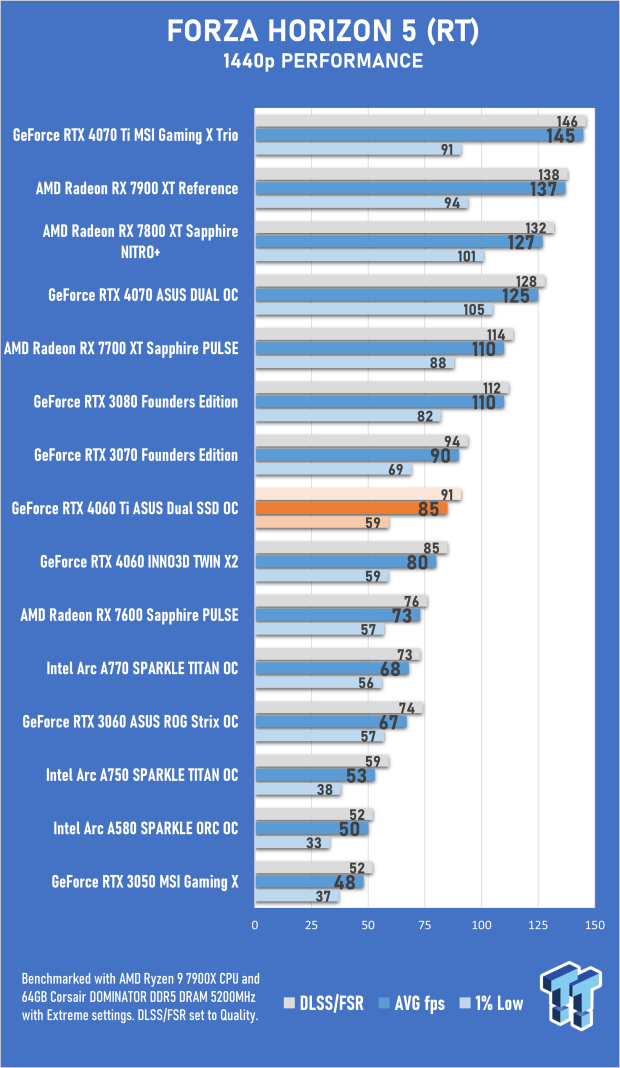
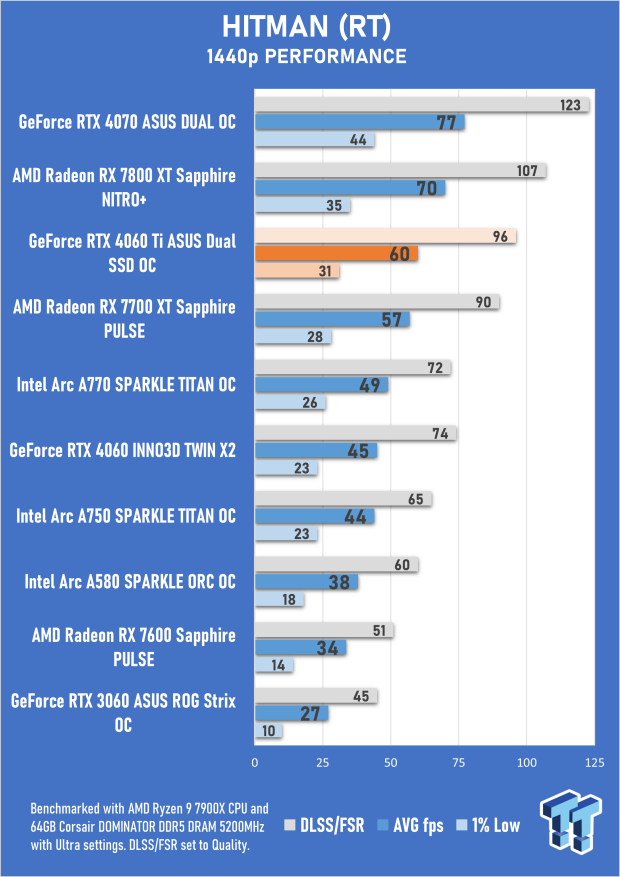
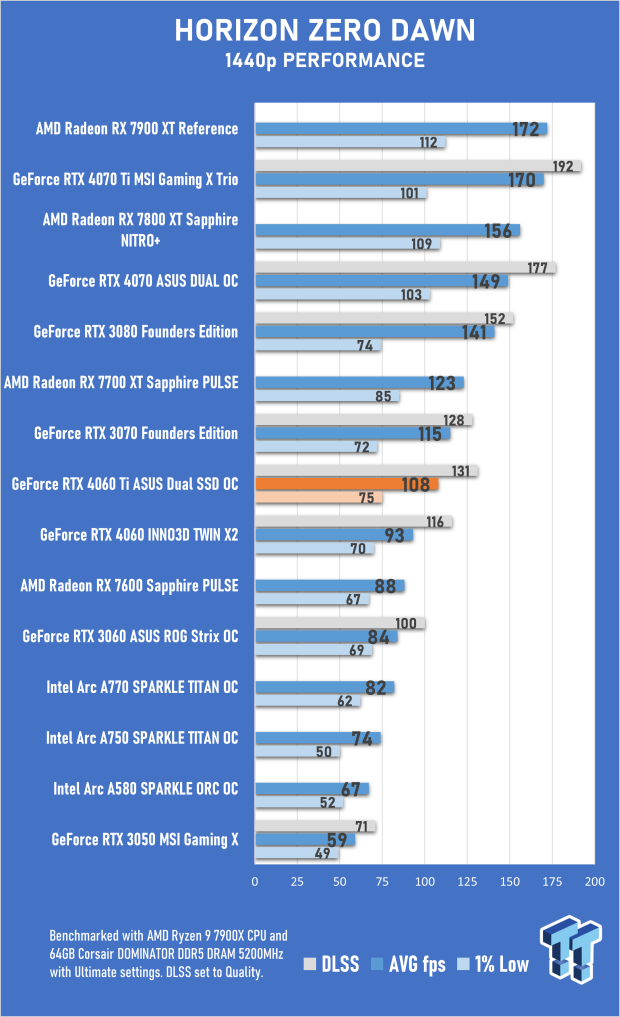
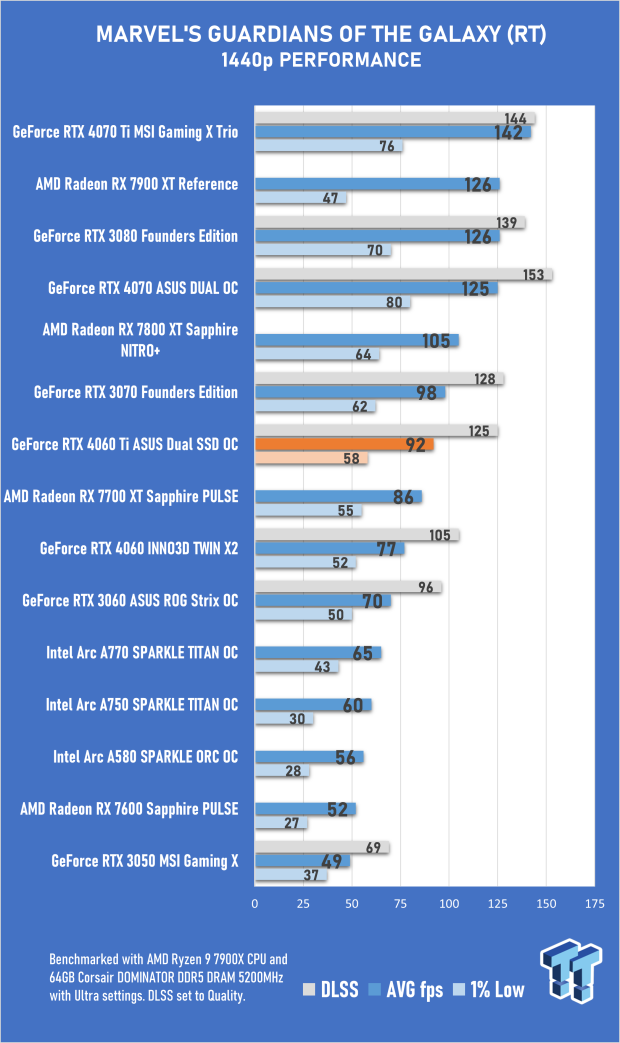
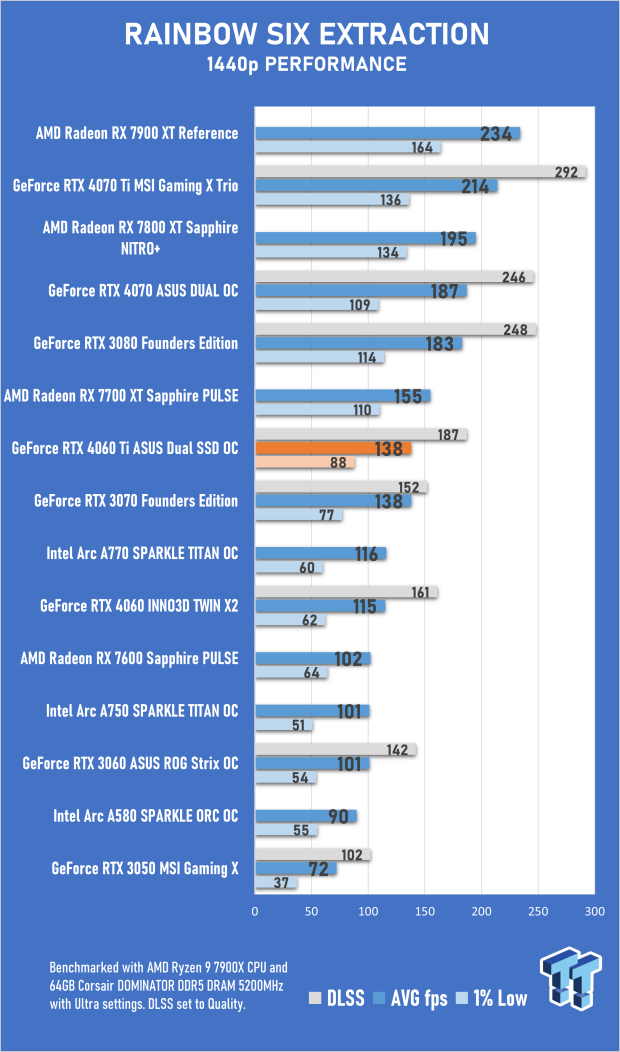
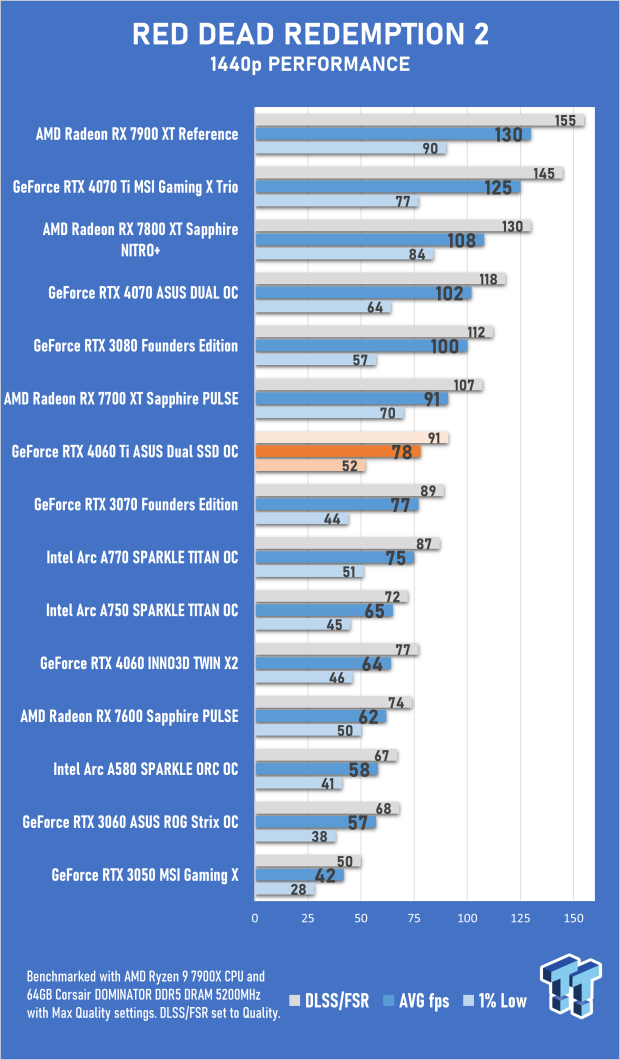
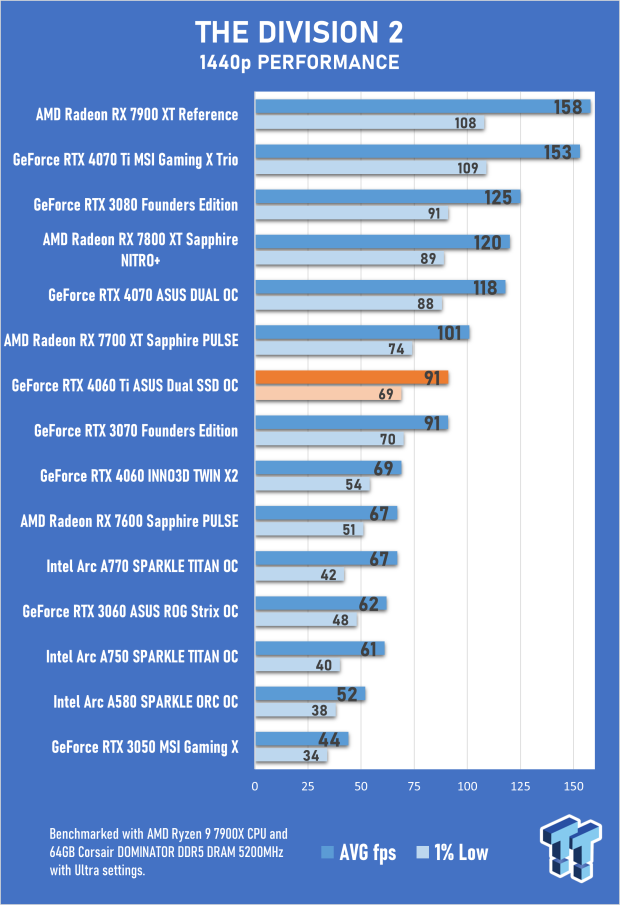
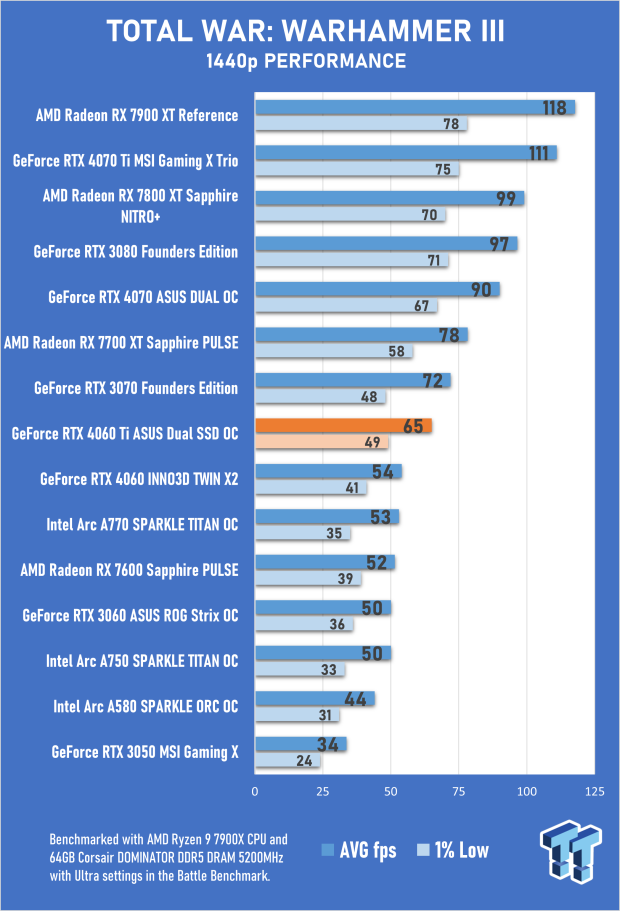
Benchmarks Summary, Ray-Tracing Performance, and DLSS 3
As a card for high frame-rate 1080p gaming, the ASUS Dual GeForce RTX 4060 Ti SSD is powerful and efficient. With the help of AI hardware and RTX technologies like DLSS, it's also an excellent 1440p option. DLSS is so common in modern high-profile PC releases that most gamers now consider launching without support a glaring omission. At 1440p using the Quality setting, the image quality is so good you'd enable it even if non-DLSS performance is fine - you might as well get some free frames.

Although the average performance is higher than the GeForce RTX 4060 and on par with the GeForce RTX 3070, there are exceptions. Cyberpunk 2077, with or without ray tracing, falls behind the GeForce RTX 3070. 1440p is where you see the biggest difference, which is a shame - because improved 1440p performance would make the GeForce RTX 4060 Ti a more attractive option.
That said, DLSS 3 Frame Generation is exclusive to the new GeForce RTX 40 Series of GPUs, and the AI-powered generated frames push perceived performance to impressive heights. Thanks to NVIDIA Reflex (which is automatically enabled every time you turn on Frame Generation), overall latency isn't an issue, and the image quality is such that it's worth enabling to hit 100+ fps in several games at 1080p and 1440p.
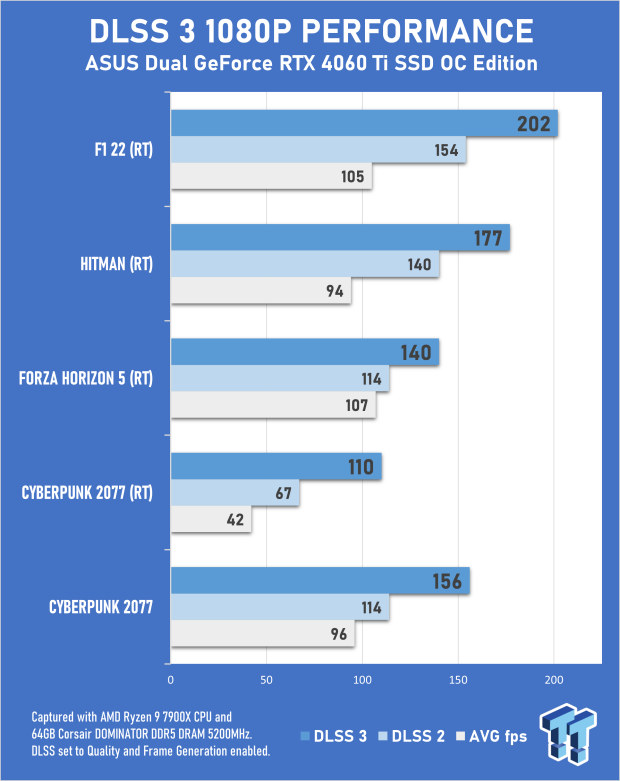
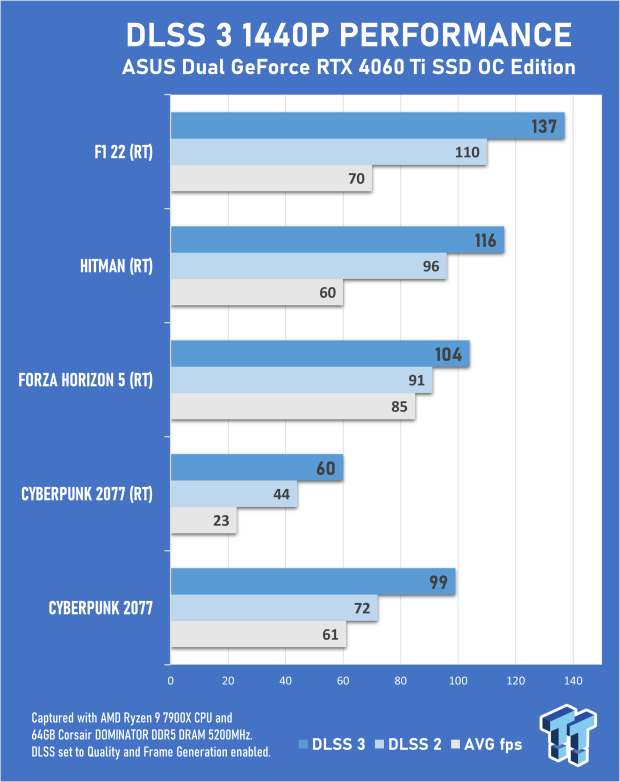
Cyberpunk 2077, using the RT Ultra setting, DLSS 3 Frame Generation (which includes DLSS Super Resolution upscaling) delivers a 2.6X increase over native 1080p rendering. In F1 22 and Hitman 3, two more games with ray-tracing, DLSS 3 delivers a 1.9X increase in performance over native 1080p rendering. Forza Horizon 5 with RT is a different story, with DLSS 3 only delivering a 1.3X increase in performance compared to native rendering.
DLSS 3, which is being adopted at a faster rate than DLSS 2 at this point in its life, is something we're probably going to see in most major PC game releases throughout 2024 - so it makes the case for picking up an ASUS Dual GeForce RTX 4060 Ti SSD or different GeForce RTX 40 Series card.
SSD Performance
Even though the GeForce RTX 4060 Ti and the ASUS Dual GeForce RTX 4060 Ti SSD are PCIe Gen4 GPUs, that doesn't mean that the M.2 slot is limited to Gen4 speeds. The PCIe lane segmentation works at the motherboard level because the GPU and SSD are treated like two separate entities, which means that if your motherboard is PCIe Gen5 capable, you can take full advantage of the added speed.
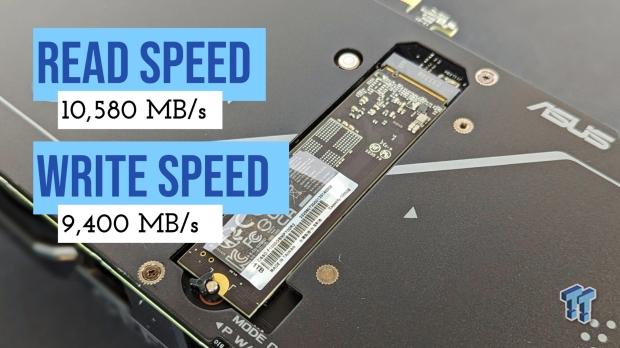
This is exactly what I did thanks to ASUS providing a 1TB version of the TweakTown Editor's Choice Award-winning Corsair MP700 SSD. As you can see above, with speeds of over 10,000 MB/s, you're left with a solution that lets you install games on the SSD connected to your GPU and then benefit from remarkably quick loading times.
Temperature and Power Efficiency
The GeForce RTX 4060 Ti, for the 1080p and 1440p performance you get, is one of the most efficient GPUs ever released. It's something you see across the entire Ada generation, but with average gaming power usage under 150W across 1080p and 1440p gaming - the ASUS Dual GeForce RTX 4060 Ti SSD is something else.
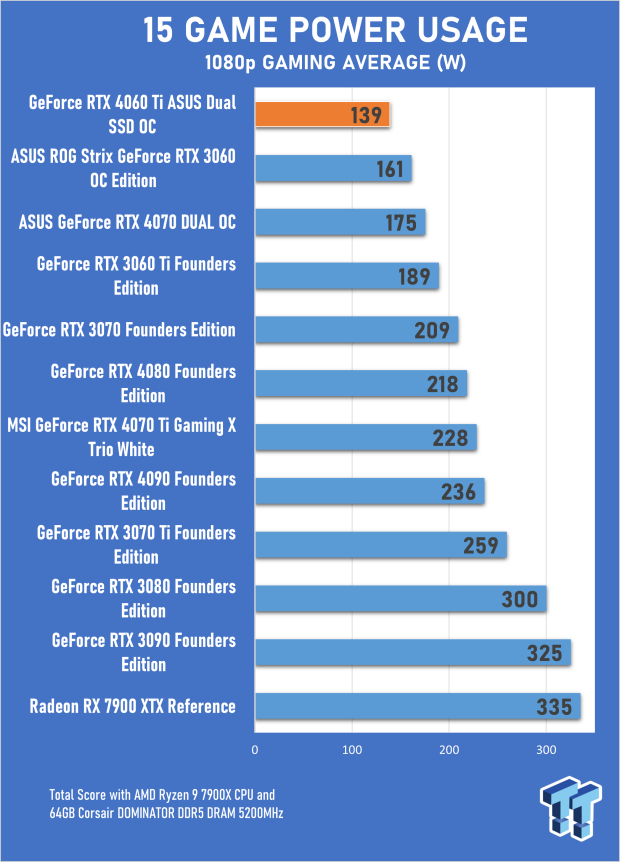
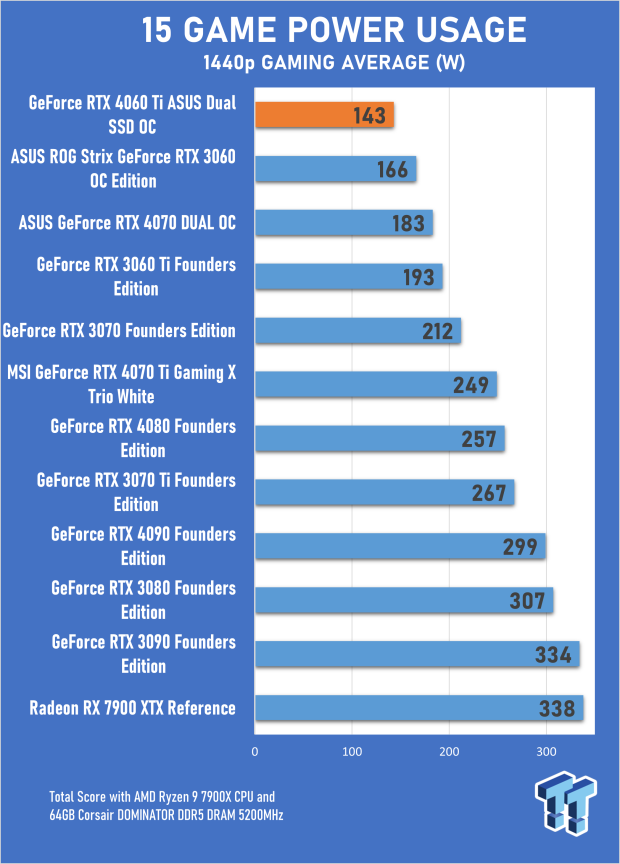
The good news is that this efficiency correlates to thermal performance, which comes down to the simple fact that the more power something draws, the more heat it inevitably generates. The Dual line-up of GPUs from ASUS has excellent cooling, and for the ASUS Dual GeForce RTX 4060 Ti SSD reviewed here - even with out-of-the-box overclocking - the GPU temperature hovers at around 60 degrees Celsius with a hot spot of around 68 degrees.
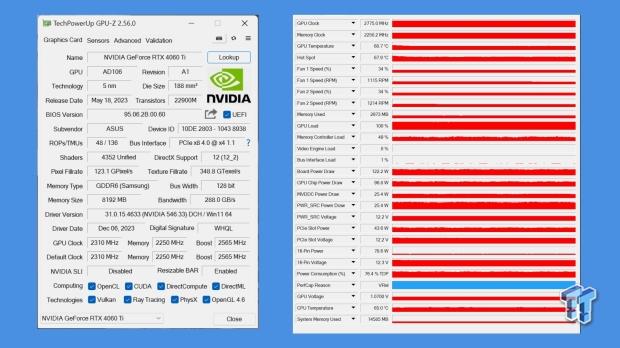
Adding to the impressive result is fan speeds not exceeding 35% with the default profile, so you're looking at quiet performance. A more aggressive fan curve can push and keep temps below 60 degrees, but the trade-off is audible fans. Oh, and as for the SSD - it turns out that slapping one onto a GeForce RTX 4060 Ti results in temperatures remaining well below the throttling threshold.
Final Thoughts
The ASUS Dual GeForce RTX 4060 Ti SSD OC Edition is a rather special GPU release; it combines the excellent 1080p gaming performance of the GeForce RTX 4060 Ti - while expanding its capabilities to include housing an M.2 SSD for expanded PCIe Gen4 or PCIe Gen5 storage. Although you'll need a compatible motherboard for this combination to work, the fact that it does - and doesn't disappoint is awesome. If you like to have a dedicated drive for games like me, it's the perfect solution because your game drive becomes one with your PC game driver - the GPU.

The only downside is that this extra functionality comes at a cost, which lowers the value proposition of the GeForce RTX 4060 Ti as at $440, it becomes close to the Radeon RX 7700 XT's MSRP of $449 USD - and AMD's card offers double-digit faster non-ray-traced or upscaled gaming performance compared to the GeForce RTX 4060 Ti. Not to mention 12GB of VRAM compared to 8GB. VRAM isn't an indicator of performance, and right now, for 1080p gaming, 8GB is plenty. Regarding efficiency, NVIDIA's current crop of GPUs is in a league of its own.
The ASUS Dual GeForce RTX 4060 Ti SSD OC Edition is something to consider if its functionality makes sense for your current build or one you want to put together. It's a one-of-a-kind release that alters a GPU's functionality, and ASUS deserves a lot of credit. Here's hoping we see more of this innovation in the future.


